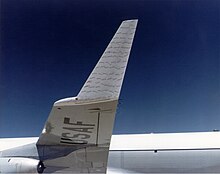
In aeronautics, tufts are pieces of yarn or string, typically around 15 cm (6 in) long, attached to an aircraft surface in a grid pattern and imaged during flight. Their motion can be observed and recorded to locate air flow features such as boundary layer separation and reattachment. Tufting is, therefore, a technique for flow visualization. They are used during flight testing to study air flow direction, strength, and boundary layer properties.
The world's largest bed of tufts (18.6 m by 18.6 m, 61 feet by 61 feet) was created at NASA Ames Research Center to study air flow fields involving a helicopter's rotor disk.
See also
References
- Prouty, Ray (1 January 2009). Helicopter Aerodynamics Volume II. Lulu.com. ISBN 9780557090440. Retrieved 19 October 2016 – via Google Books.
- Wadcock, Alan J. (October 2008). "Rotorcraft Downwash Flow Field Study to Understand the Aerodynamics of Helicopter Brownout" (PDF). Defense Technical Information Center (DTIC). Retrieved 1 November 2022.
This aviation-related article is a stub. You can help Misplaced Pages by expanding it. |
This fluid dynamics–related article is a stub. You can help Misplaced Pages by expanding it. |